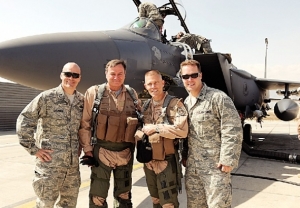Coming home from Bagram
By Kenneth Fine
Published in News on April 18, 2010 1:50 AM

U.S. Air Force photo
U.S. Ambassador to Afghanistan Karl Eikenberry and 455th Expeditionary Wing Commander Brig. Gen. Steven Kwast, center, stand in front of an F-15E Strike Eagle at Bagram Airfield, Afghanistan, last month. Eikenberry, a Wayne County native, was at Bagram to get an orientation flight in a 494th Expeditionary Fighter Squadron F-15E, flown by Kwast, former 4th Fighter Wing commander.
A few thousand feet above the Hindu Kush mountains, Brig. Gen. Steve Kwast urged the others seated in a C-12 bound for Kandahar to look out the window at the campfires burning across the valley.
"Those people down there just want what all of us hope for," he said during that flight last July. "They want a chance to raise their children and love their families."
And since he took command of the Bagram Airfield-based 455th Air Expeditionary Wing, the former 4th Fighter Wing commander said the country's nationals have gotten closer than ever to achieving that simple goal -- thanks, largely, to the efforts of airmen from the Goldsboro Air Force base he says he will always call home.
Roughly a week before Kwast is set to touch back down on American soil, he talked about the last year in Afghanistan -- just how much has changed in the country since his stint began, the bright outlook he sees for future generations there, and how members of Seymour Johnson Air Force Base's 4th Fighter Wing led that charge.
"The one thing that is a deep sense of pride for me, at the apex of the demand and the work, Seymour Johnson is the one who was here," he said. "They shouldered the most kinetic and most hard-working part of this pivotal year in the history of Afghanistan, from the elections in the summer and the most violent point in the country's history, to the presidential surge."
But the increase in demand for air power -- particularly, close-air-support requests that ended up reaching F-15E Strike Eagle air crews from the 4th's 336th and 335th Fighter Squadrons -- never felt like a burden, a testament, Kwast said, to the highly skilled and well-prepared aviators and maintainers from Seymour Johnson who answered those calls.
"Seymour Johnson led the way ... and set the bar so high for everybody else. That makes me so deeply proud," he said. "(They) set the bar. They basically set the gold standard. ... (They) had prepared to a level that we had never seen before."
*
Kwast knows the fight for a free Afghanistan is far from over.
But he allows himself to be optimistic -- not just because of how the airmen he has commanded for the past year have impressed him, but more importantly, because of how drastically life has changed for those who called the country home long before the U.S. deployed forces there.
"When we started here, there were only about 560,000 kids going to school in Afghanistan. There are now over 6 million children going to school," Kwast said. "When we started here, none of the roads were paved and the ones that were had been destroyed by war and travesty. ... Kabul was a ghost town and now there is such .. business, you are stuck in traffic jams ... because it's such a thriving city.
"(These examples), they scream progress. They scream security. They scream hope for the future. So you better believe I'm optimistic."
And during his many visits with U.S. Ambassador to Afghanistan Karl Eikenberry, a Wayne County native, the bright outlook he sees for the country has been reinforced.
"We are seeing this contagious reaching out of the tribes to the government wanting to be a part of this excitement and that future. This is a fever that is growing in Afghanistan," Kwast said. "I see it in spades, and I'm very hopeful. (The Afghan people), they do not want that evil. They don't want that oppression. They don't want that violence.
"So Goldsboro should be so proud of (Eikenberry). ... He is one of the main reasons this place is surging."
Just as the tireless efforts of Seymour Johnson airmen recently deployed to Bagram is the reason hundreds of air power campaigns in support of Coalition troops on the ground were successful.
So as the 336th prepares to rejoin the fight this fall, their former commander offered some rather simple advice: Follow the same path that led to those recent victories.
"Airmen from Seymour Johnson, when they show up, they blow everybody else out of the water," Kwast said. "So just follow that template."
Shortly after Kwast returns home, he will take on his latest assignment at the Pentagon, helping the chairman of the Joint Chiefs of Staff advise the president on political and military policy as it relates to Europe, NATO and Russia.
